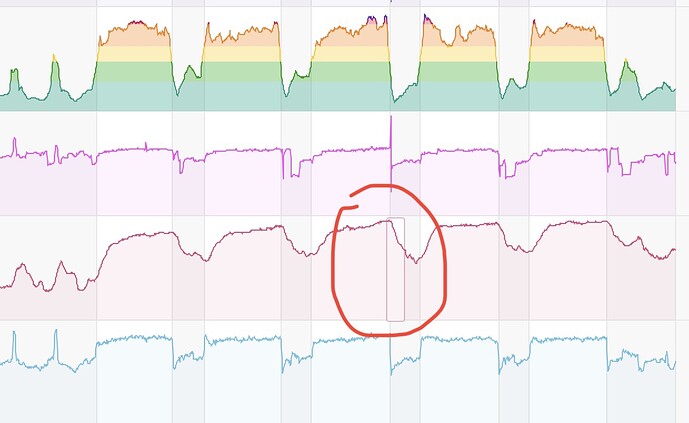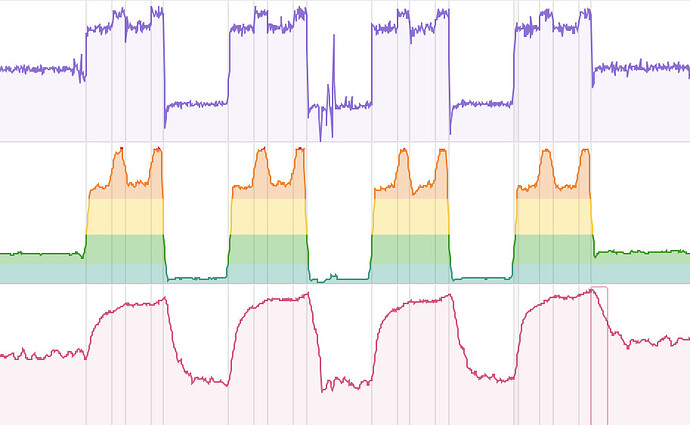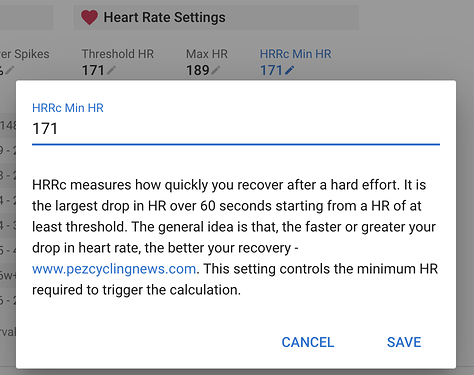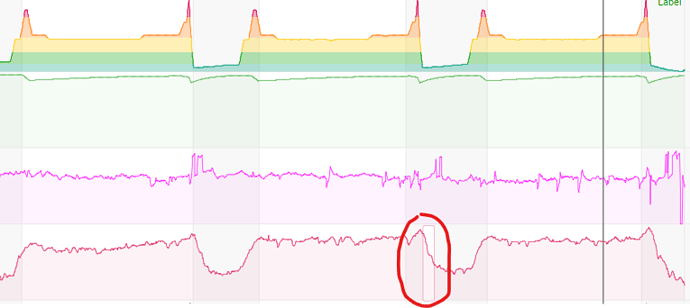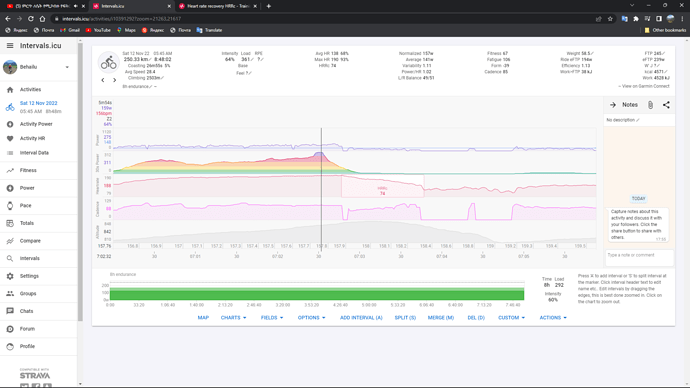It isn’t always at the end of a workout. It’s the biggest drop in HR after going over your threshold.
Example bellow shows on interval 3 of 5:
Coming back to this,
- I am wondering why HRRc is only evaluated when one goes over THR? I.e., when I do SST intervals I never get over THR yet still see very significant HRRc’s of ~40 over 1 min at the end of the intervals – and I’d like to have them quantified;-)
- Maybe it would be a useful plot to see HRRc against the HR from which it actually dropped, as a function of HR_peak or a function of time (date) – anything known about this, any thoughts?
I just assumed that looking at HRRc for starting values less than threshold wouldn’t be very interesting. I could relax this a bit but it would still be useful to have some min starting value (maybe 10 beats under LTHR?) just to avoid a lot of noise.
This can be done and is now on the todo list.
Yes, the “noise problem” is obviously there…
One thing is the rule along the lines of “1 min @ x” mentioned above.
Maybe x could also be a user setting defaulting to the current assumption of THR – which would have least impact on “standard” users.
For me HR during SST is often (just) below 0.9 * THR, the latter derived from 20 min tests.
SN: Which reminds me of the point that for me TRIMP loads are often a lot smaller than power based loads and that I was wondering if this was normal or a sign of poorly set (too high) THR? What would be the appropriate topic in the forum for such a discussion?
I think I will change it to be LTHR less 10 bpm. Thats simple enough and shouldn’t annoy anyone too much.
HRSS depends quite a bit on your resting HR being set correctly so it could be that?
Well, it’s too high a threshold for me. In fact, for me LTHR - 10 > 0.9 * LTHR > HR(SST).
The latter is which I would like to be incorporated in the HRRc analysis – how fast does it drop after a 10 /20/30 min SST intervals, etc. 
I assume that is the HR_rest set in the settings – which is set to a quiet reasonable value for me – these last weeks it is really about the average of my daily resting HRs.
This does not seem to be the issue here.
Nevertheless, would it be possible to have the resting-HR in the settings updated form my daily HR-data uploads using HealthFit?
Still wondering if maybe my LTHR is set too high, but it does come out like this from FTP tests/etc.
But also the TiZ looks very different for power and HR:
For Monday’s “tempo” ride the power distribution was
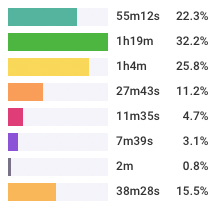
whereas the HR distribution looks like this
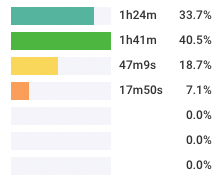
HealthFit should already update that field.
It does
(… although I am fairly certain that the field read 50 yesterday, but none of the recent readings is 50;-)
Also it did not really help my original question on HRSS (norm. TRIMP). Todays outside ride has these HRs and loads
![]()
Resting HR is from Apple Watch/Health, it is in line with (but not taken from) the HR of a 5 min mindfulness session in the morning…
Following up here, what‘s the status on being able to get a lower threshold HR for HRRc analysis?
Would be very useful:-)
One further example from yesterdays over/under intervals that shows a „funny“ HRRc because only on the very last I got to LTHR, so it determined HRRc there – but because I did not go all the way deon to „easy“ after the over, it did not „recover“ as much as on earlier intervals – yielding too low a value.
I added that in /settings for each sport with HR zones. The value is stored as a percentage of LTHR so if you change your LTHR it adjusts.
Please tell me if I understood the meaning of HHRc correctly?
Threshold heart rate - 176.
I run 5 intervals in the heart rate at the peak of 182.
After the last interval, I look to what value the heart rate drops from the level of 176 bpm in 60 seconds (146).
HRRc = 176-146 = 30 beats/min.
In the settings of the heart rate zones, I try to specify HRRc = 30, but I can’t, the following message appears - “LT HR must be between 80 and 220”.
-
You must set your LTHR (176) in Heart Rate Settings, and not the HRRc of 30.
-
You mention intervals. If the duration between intervals is greater than 60 seconds, it will be the interval with the highest HRRc after each interval. In this example, my second interval has a better HRRc compared to the first and last interval.
Thanks, now it’s clear
Now I understood how HRRc works on intervals.icu. I use Garmin and it has a feature called Recovery HR. It takes your Heart Rate 2 minutes after you finish an activity. I thought HRRc was like Recovery HR. Is it possible to take Garmin Recovery HR? Don’t you think garmin methodology is more precise, considering the drop on HR after finish the training? Because if I reach my HRRc Min HR and slow down a little bit for a minute the HRRc will be small number and if I stop completely the HRRc will be a much bigger number. But I don’t think it’s wise compare this data, because it happens in different conditions.
The most common measurement is 1 minute after exercise. A number of applications use this times period, even though some use 2 minutes (Garmin) and up to 3 minutes.
Which ever you choose to use, keep using it. Consistency is the winner.
I will pose the question, to my mentors, of why there three methods and which is the preferred method (they know where to get the data from the medical journals, a lot more efficiently than me).
I completely agree with you! Consistency is the winner.
If possible, bring us this feedback!
And about the HRRc, do you think it’s possible to take Garmin Heart Rate Recovery and implement this feature @David?
This doesn’t make any sense. It’s totally unclear to me what you could do with that number.
Normally, what happens, is that you do a hard effort and then reduce intensity to somewhere around 50%FTP or lower. That gives you the opportunity to get rid of waste products in the muscles. The speed at which your HR lowers is an indication of how easy it is for you to recover from that effort.
I absolutely don’t have any intrest on what my HR is at the end of a workout. If all goes well, you’ve done a good cooling down by simply spinning the legs…
It would only be meaningful if you just finished a sprint to the line, then it should be similar.
Agree with this. The garmin approach requires you to do a surge at end of workout, then end the workout, and only then do a cooldown, to get useful data.
It’s only meaningful in very limited use cases.
